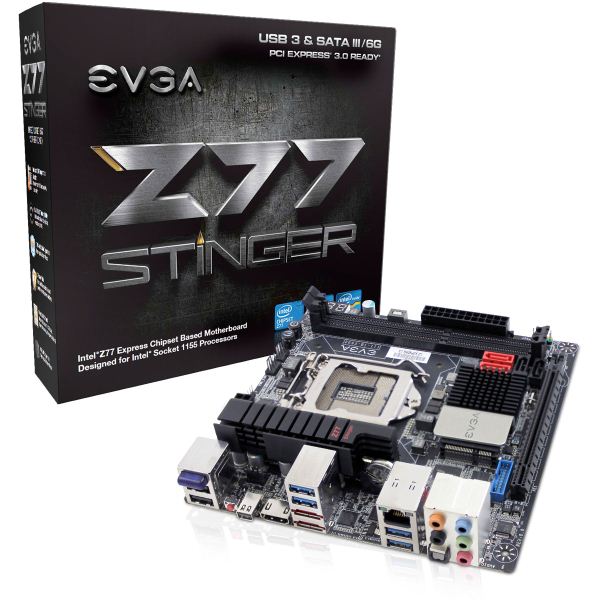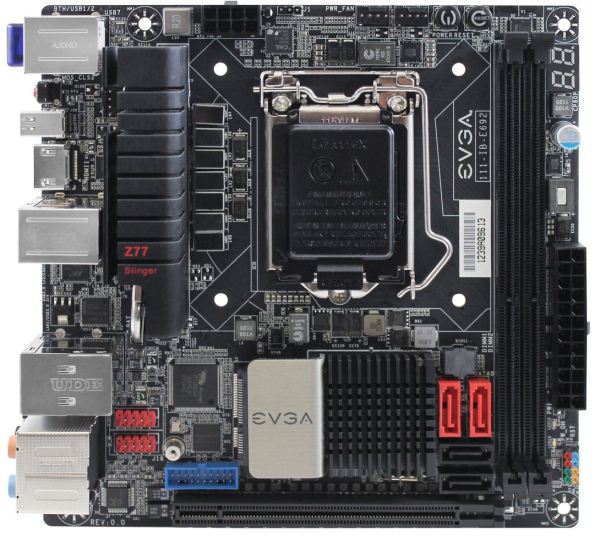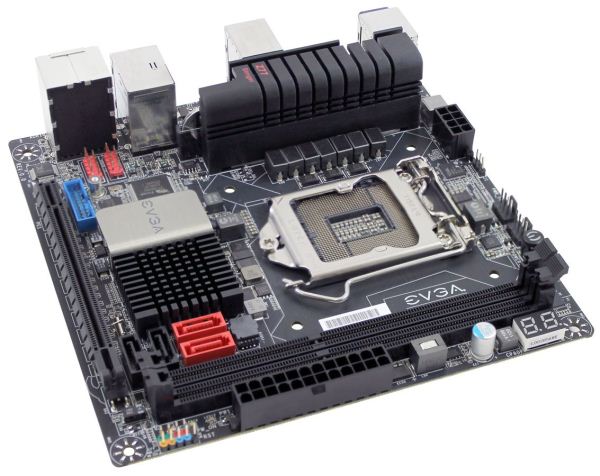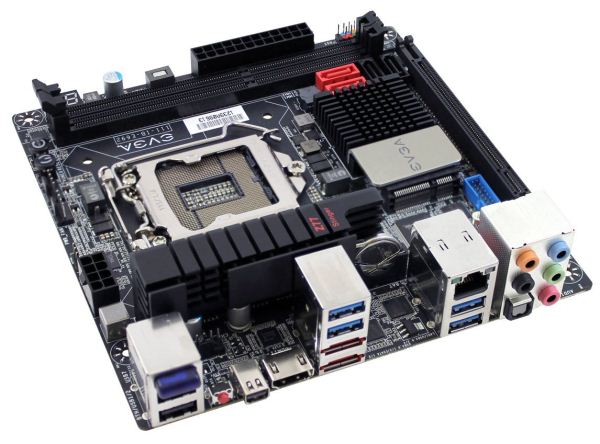Z77 mITX Round-Up: Five of the Best – MSI, Zotac, ASRock, EVGA and ASUS
by Ian Cutress on December 31, 2012 7:00 AM EST- Posted in
- Motherboards
- MSI
- ASRock
- EVGA
- ZOTAC
- Asus
- Ivy Bridge
- Z77
- mITX
EVGA Z77 Stinger Overview
For the fourth motherboard of this review, the design philosophy of the Z77 mITX board takes a turn on its head – almost literally. We find the socket moved to the top, and the chipset placed underneath. This ultimately gives more freedom when it comes to placing CPU coolers, albeit the EVGA Z77 Stinger is still limited in one dimension due to the close proximity of the memory slots. Users can happily place a longer cooler in the other direction though.
As a price of $200, it certainly raises the asking cost for a mITX board to new heights. A good number of great ATX sized motherboards are already at this price, including a few we have awarded. This instantly makes the EVGA a tougher sell, but in order for a little compensation, EVGA get heavy handed with some of the features.
We get an Intel NIC on board unlike the other mITX so far, but on the downside it is coupled with the Realtek ALC889 which failed our 192 kHz testing. We get a mini-PCIe slot, though with no WiFi module like with some of the other boards. EVGA have decided to up the total USB 3.0 count to six with an ASMedia controller powering the onboard header as well as upping the SATA 6 Gbps count with a Marvell controller powering the two eSATA 6 Gbps on the rear IO. The EVGA is also one of few boards to have the power/reset button combination with a debug LED that changes to a CPU temperature monitor after POST. If anything the rear IO looks a little sparse, with HDMI and mini-DisplayPort being the only options for video output. It looks like some of the connectivity had to be lost in order to fit a couple of the controllers on board.
EVGA are still not completely on the bandwagon with a graphical and interactive BIOS, showcasing a white text on black scenario. To make matters worse, XMP is not properly implemented in the first BIOS release, and returning to optimized defaults changes everything back to normal except the BCLK. On the software side, the driver install is a one-by-one affair which requires user interaction despite the fact that these driver installs when sent to EVGA offer silent install modes. The only software we get is EVGA E-LEET which allows the user to adjust the overclocks and priority of programs on the fly – it is for all intents and purposes an advanced version of CPU-Z. Fan control is not in the software – that is solely for the BIOS.
Performance of the EVGA is on par with the other motherboards tested – nothing comes out as overly great or bad. This makes a $200 mITX a tough sell – it has the socket position I prefer and an Intel NIC, but the support behind the motherboard in terms of the BIOS or Software pale in comparison to the cheaper models. One upside of purchasing an EVGA board is that all RMA requests are direct with EVGA rather than the supplier, which may add to that additional cost as well.
Visual Inspection
As noted in the overview, the main comparison with the previous motherboards and the EVGA is the location of the socket area. Here the socket is above the chipset, which changes a lot to do with port location. Our 8-pin CPU power connector is now at the top edge of the board with a pair of four-pin fan headers. As the chipset is underneath the socket, so are the USB 2.0 and USB 3.0 headers and the SATA ports. The result is a mixed bag, with USB cables having to stretch over components in order to fit into the board.
Unlike most of the other mITX boards, we get three fan headers – two located to the top right of the socket (both 4-pin) and another on the rear IO side of the power delivery heatsink (also 4-pin). The socket area still caters in the left-right direction to the Intel minimum specifications, meaning that coolers that conform to at least one of the dimensions should be placed such that any full sized memory does not interfere.
With the chipset below the socket, our SATA ports are in the bottom right area between the memory slots and the PCIe device. The orientation of the SATA ports is going to give issues if any need to be taken out, requiring most of them to be removed each time. To the left of the chipset is a mini-PCIe (not mSATA) port for a WiFi/WiDi module, which is not included in the package – this is in contrast to the other mITX motherboards tested which do have one.
Along the top right of the motherboard are a pair of power/reset buttons which I always find useful in testing. To the right of these is a two-digit debug LED, also useful for diagnosing issues. This two-digit debug LED turns into a CPU temperature readout after POST, which is an awesome feature to have. Unlike some other mITX builds, the Front Panel connector is found at the bottom right of the motherboard in an ideal location for most orientations.
The rear IO panel is a little different to the previous motherboards tested. Normally the rear IO is fighting for space to fit in all the different connectors wanted on the product, but EVGA have decided to cut some of the fluff and stick to components they think most of their users will want to use. From left to right we have a BlueTooth module, two USB 2.0 ports, a Clear_CMOS button, a mini-DisplayPort, HDMI, four USB 3.0, two eSATA 6 Gbps, an Intel NIC, and audio jacks from the Realtek ALC889.
Board Features
| EVGA Z77 Stinger | |
| Price | Link |
| Size | Mini ITX |
| CPU Interface | LGA-1155 |
| Chipset | Intel Z77 |
| Memory Slots |
Two DDR3 DIMM slots supporting up to 16 GB Up to Dual Channel, 1066-2133 MHz |
| Video Outputs |
HDMI mDP |
| Onboard LAN | Intel 82574L |
| Onboard Audio | Realtek ALC889 |
| Expansion Slots |
1 x PCIe 3.0 x16 1 x mPCIe |
| Onboard SATA/RAID |
2 x SATA 6 Gbps (Chipset) RAID 0, 1, 5, 10, 0+1 2 x eSATA 6 Gbps (Marvell) RAID 0, 1, 5, 10, 0+1 2 x SATA 3 Gbps (Chipset) RAID 0, 1 |
| USB |
4 x USB 3.0 (Chipset) [4 back panel] 2 x USB 3.0 (ASMedia ASM1042) [2 onboard] 6 x USB 2.0 (Chipset) [2 back panel, 4 onboard] |
| Onboard |
2 x SATA 6 Gbps 2 x SATA 3 Gbps 1 x USB 3.0 Header 2 x USB 2.0 Headers 1 x Front Panel Header 3 x Fan Headers Power/Reset Buttons Debug LED |
| Power Connectors |
1 x 24-pin ATX Power Connector 1 x 8-pin CPU Power Connector |
| Fan Headers |
1 x CPU (4-pin) 2 x PWR (4-pin) |
| IO Panel |
1 x Bluetooth Module 2 x USB 2.0 1 x Clear_CMOS Button 1 x mDP 1 x HDMI 4 x USB 3.0 2 x eSATA 6 Gbps 1 x Intel NIC Optical SPDIF Output Audio Jacks |
| Warranty Period | 3 Years |
| Product Page | Link |
For the large $200 price tag for the Z77 Stinger, the lack of a WiFi module on board is a little disappointing, as well as the use of the Realtek ALC889 rather than anything higher up the Realtek order catalogue. On the plus side we do get an Intel NIC, an additional USB 3.0 controller, an additional SATA 6 Gbps controller (for eSATA ports) and, in my opinion, a better oriented mITX motherboard. Also that third fan header is one more than most mITX motherboards.














54 Comments
View All Comments
Bullwinkle J Moose - Monday, December 31, 2012 - link
Hey yeah, Ian haz a good pointThat Crappy Gigabyte H61n-USB3 doesn't have Chipset USB3
But it does however boot just fine to a USB3 Windows to go drive at USB3 speeds
It also boots to Linux and XP due to the Non-Locked down Bios so we wouldn't want that either would we
and it takes a full 9 seconds to boot XP compared to the super de duper fast 7 second Windows 8
So we should spend more money and get locked into a closed system
After all, that is the future!
Limitations are fun so be happy as we lock down the Internet as well
After all, there are scarey Monsters out there
A man has to know his limitations
Clint Eastwood
Bullwinkle J Moose - Monday, December 31, 2012 - link
Ian haz a good point about the memory tooThat Gigabyte H61 board only takes up to 16GB of RAM
How much do these Z77 boards take by the way?
Was it this site or Maximum PC where the reviewers stated that in everyday use, you will notice no difference in speed between Sata 2 & 3 when you are using the latest and greatest SSD so I probably don't need the RAID capability on my H61 either
Keep up the good work Ian
Death666Angel - Wednesday, January 2, 2013 - link
It seems that someone just discovered sarcasm. Good for you!mczak - Monday, December 31, 2012 - link
H61 is not limited to one single sided DIMM per channel, double sided are just fine. It only accepts one per channel (at least it's specced that way) but since none of these mini-ITX boards have more than two memory slots this wouldn't matter at all here (max memory is still 2x8GB regardless).Frankly I'm not sure losing PCIe 3.0 is a big deal with mini-itx boards in any case but either way it isn't exactly true there are h61 boards supposedly supporting this (as it's got nothing to do with the chipset anyway all the pcie 3.0 signals coming directly from the cpu, though it would require bios support).
This leaves us with losing SATA 6 Gbps - this might indeed make some minimal difference in real world, provided you use a SSD and not a HD.
The major point imho (aside from overclocking) would be missing USB 3.0, which obviously makes a big difference when using external harddisks etc. Granted that could be done with separate usb controller but probably not a good idea since space is limited.
H61 IIRC also will lose the possibility of using 3 display outputs simultaneously. Maybe something like H77 would make more sense for mini-ITX as it pretty much only loses overclocking (plus the ability to split the 16 x pcie 3.0 lanes into 2x8 though I guess this has nothing to do with the chipset itself really, but in any case it won't be missed on mini-itx). So if you don't want to overclock, you wouldn't miss anything at all with H77 on a mini-itx board.
Etern205 - Saturday, January 5, 2013 - link
I also notice that as well, most sites will only review Z77 mITX boards instead of H61 or H77. Not all will need a Z77, Z77 is mostly for enthusiast or for those who are into the technical stuffs. For the average Joe or Jane any mITX board will do. If you tell them it's H61 or Z77, they probably won't care too much on the difference.piroroadkill - Wednesday, January 2, 2013 - link
You can't easily upgrade the chipset later. With a small up-front investment, you get the full feature set, and why not?Bullwinkle J Moose - Sunday, January 6, 2013 - link
Oh Boo Hoo, I can't easily upgrade to an overclocking chipset or void the warranties of my hardware componentsI am just stuck with a totally stable system
Boo Hoo
How can I possibly break this ?
What has the World become ?
Poor me
Boo Hoo
Bullwinkle J Moose - Sunday, January 6, 2013 - link
Why not?Because the H61 is exactly what I wanted
and anything else is NOT !
can you hear me now?
EVGA KINGPIN - Friday, November 19, 2021 - link
I still use my Z77 FTW board , have had it running without turning it off since 2015. evga is the best ,also my EVGA GTX 980 KINGPIN is still running strong,,,thanks EVGA for quality products, JRTsherlockwing - Monday, December 31, 2012 - link
Where is the Gigabyte?